Yalta onion is a well-known southern variety of this plant, which has a standard taste and appearance. Growing such a crop in the middle lane is possible, but not justified, because the resulting bulbs are fundamentally different from those grown in the southern region.
Table of contents
Description of Yalta onion
Yalta onion is a relative of the Madersky flat variety, which was introduced to the Crimea in the 19th century travelers, hence the second name of the species - the Crimean onion.The described plant belongs to lettuce varieties and has many positive qualities, the main of which is a low content of essential oils, so that the bulbs do not irritate the mucous membranes, and in their taste there is no bitterness and sharpness.
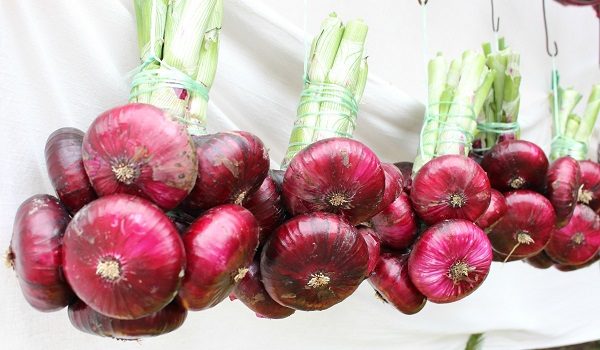
Dry scales, which are a protective layer, can be painted in purple or pink. Juicy scales, up to 7 millimeters thick, are painted in white or pale pink, in one head there are no more than 7 such layers. The bulb has a slightly flattened round shape. The main advantage will be its taste, in which there is no pronounced bitterness and sharpness.
The growing season is within 140-150 days.From this we can conclude that a plant takes a long amount of time to fully ripen the fruit.
How to distinguish the Crimean onions from other varieties?
Yalta salad onions are often forged.On the shelves of shops you can see the red heads, which do not have the main features of the variety, but are called by its name. To avoid similar situations and to distinguish the Yalta look from fakes, It is necessary to pay attention to the following signs:
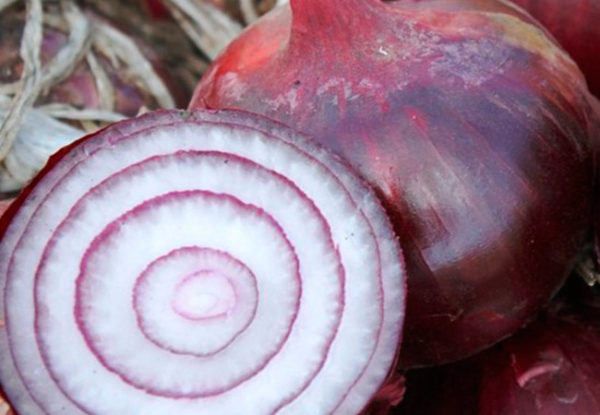
- If you cut the onion in half, you can see that it consists of several thick and juicy layers, whose number does not exceed 7 pieces;
- Yalta bow does not cause lacrimation and other body reactions. There is no pronounced odor;
- To taste such fruits are sweet and pleasant, there is no bitterness and sharpness;
- Ripening falls on July, and the shelf life of ripe heads does not exceed 4-5 months. If we take into account this factor, we can conclude that it is impossible to purchase such a bow in late winter, spring and early summer.
Growing seedlings
In order to grow Yalta onions in the garden plot, it is first necessary to reproduce the seedlings. Seeds are sown in a greenhouse or greenhouse in late February and early March. In the event that the optimum temperature has not yet been established, the containers with the seedlings are placed at home on the windowsill.
As a fertile substrate for germinating seeds, a mixture consisting of equal parts of sod land and humus and 50 grams of mineral fertilizers is used. Earth is poured into the container so that the thickness of the soil layer does not exceed 15 centimeters.
Growing seedlings begins with sowing seeds. They are placed in the grooves, located at a distance of 5 centimeters from each other. The distance between the individual seedlings will be 1 centimeter. Seeds spread on the surface, sprinkled with soil and sprayed from the spray.
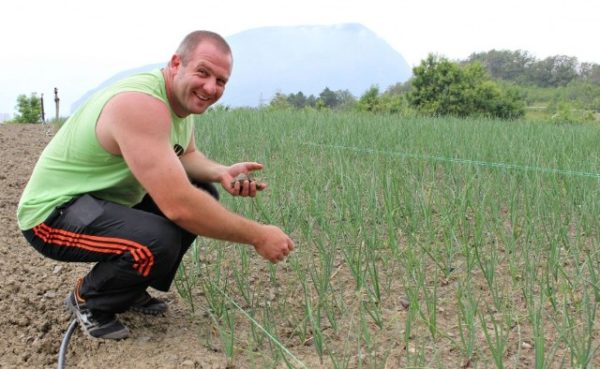
In order to grow as many shoots as possible, you should follow the following rules for growing plants:
- Initially container with seedlings kept in a warm and well-lit place with air temperature not less than 25 degrees;
- 2-3 weeks after sowing the seeds, the first shoots should roll, In this case, the container is transferred to a cooler room with a temperature of 15-20 degrees, while the lighting remains at the same level. This is necessary in order to prevent the seedlings from being pulled out;
- Topsoil should always be wet;
- 2 weeks after sowing, plantings are fertilized with complex mineral and nitrogen fertilizers. A week later make ammonium nitrate;
- As soon as the seedlings grow, they are thinned out in such a way that the distance between the plants is not less than 1 centimeter;
- Before planting seedlings soil the amount of watering gradually reduced.
Planting in open ground
Planting in open ground begins with the selection of a site for culture. It must meet the following requirements:
- The place should be under the open sun, because it is this factor that influences the taste and quality of the bulbs;
- Under natural conditions, Yalta onion grows in areaswhere the soil is the Tauri shale. At home, you need to create conditions as close as possible to the natural. The soil must be fertile;
- The plant is not recommended to be planted where other varieties grew. The best precursors are potatoes, cabbage, tomatoes and greens.
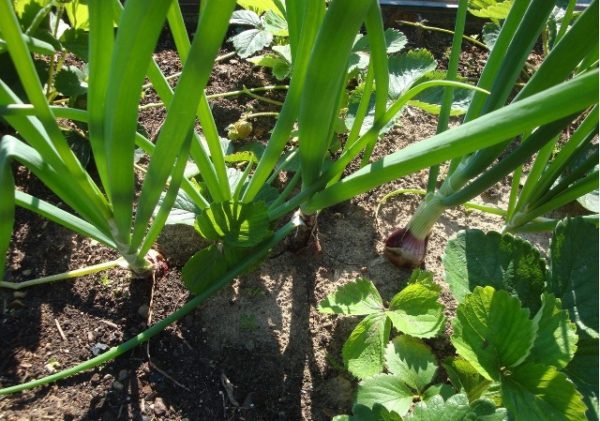
In the fall, the soil is carefully dug up to a depth of 30-40 centimeters. At this time, the earth is leveled and cleaned of debris and weeds. It is also necessary to make fertile and mineral compounds. In spring, the soil is fed with ammonium nitrate and potassium salt.
Seedlings are planted in open ground in early April, if you miss the deadlinesthen it can significantly reduce the yield.
For planting make shallow grooves with a width of at least 40 centimeters. The same distance is left between the furrows. Seedlings are planted at a distance of 10 centimeters from each other. After the onion roots are filled, the soil is compacted and watered thoroughly.
Care culture
In order to get a rich harvest you need to properly care for plantings. The sweet and juicy taste of Yalta onion depends on the number of irrigations. Do not allow the soil to dry out; it should always be in a moist state. If you do not take into account this rule, the heads will be sharp and bitter.
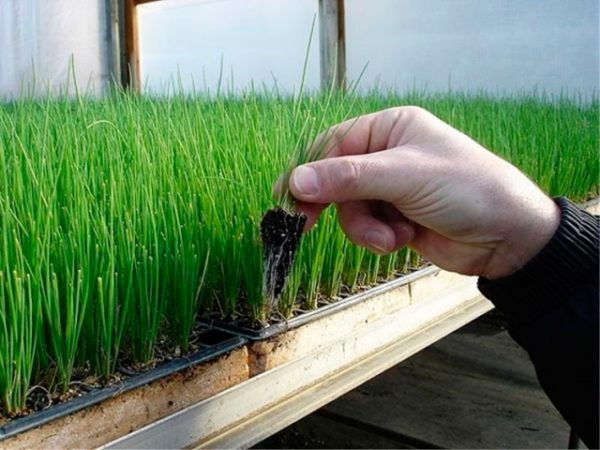
For the full development of the bulbs, the earth is regularly weeded and loosened. This is necessary for the plant to receive as much sunlight, oxygen and moisture as possible.
Yalta bow is very responsive to fertilization, so until the end of July it feed every 10-12 days, alternating with the following compounds:
- mullein, diluted in water in a ratio of 1k5 or chicken droppings, diluted with water in a ratio of 1k10;
- 20 grams of potassium chloride and 40 grams of superphosphate, dissolved in 10 liters of water.
Diseases and their prevention
Yalta onion has good resistance to various diseases. The only threat will be the possibility of rotting of the roots when the soil is wetted, therefore watering of plants should be carried out abundantly, but moderately.
Other methods of disease prevention will be the timely implementation of all agricultural work. A plant that receives proper nutrition copes with problems much better.
Harvesting and Storage
Harvesting falls at a later period, compared with other varieties, namely at the end of August-early September. It was at this time that the Yalta onion reached the peak of its maturity. It is worth remembering that you can not delay the work of digging the harvest, because the autumn rains can cause rotting of the fruit.
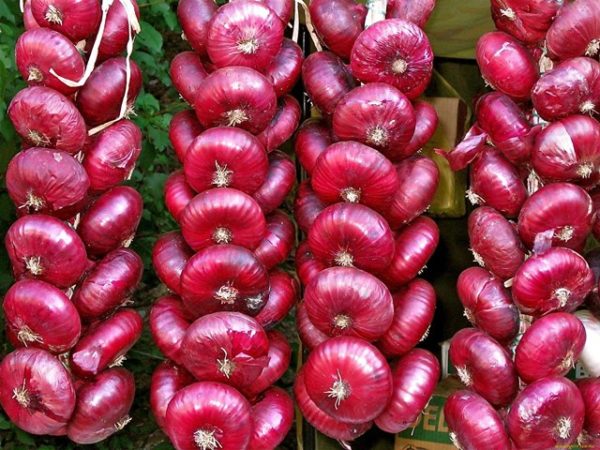
Under all conditions of storage, onions can maintain their freshness for 4-5 months:
- The air temperature should be in the range of 10-15 degrees;
- The air must be dry, the crop is best kept at a humidity of 50 percent;
- The bulbs are tied together by long shoots. The original storage method will be the manufacture of onion braids. In any case, the associated fruits are hung from the ceiling to avoid touching them to each other.
Yalta onion is one of the most delicious and famous salad varieties, but it can only be grown on the territory of the Crimea.In other localities, fruits lose their attractive taste and other properties. Agricultural cultivation of a variety requires certain skills and a solid approach to business.
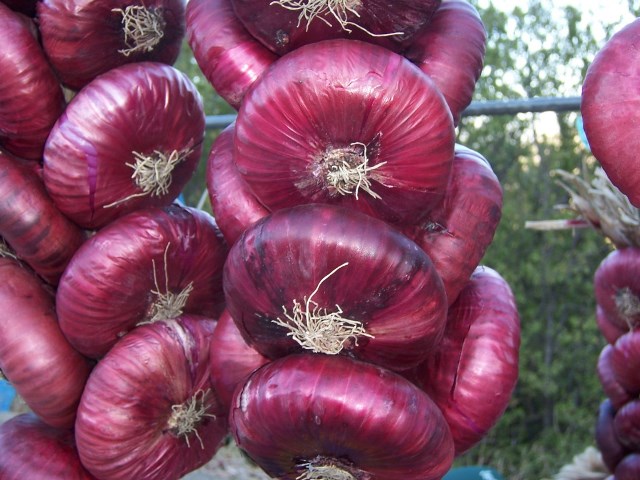
Vyborg grows beautifully and the taste is not worse, maybe even better than that of onions from the Crimea. Now, on August 8, individual bulbs have grown to 10 cm in diameter. Let's see what will happen in September.